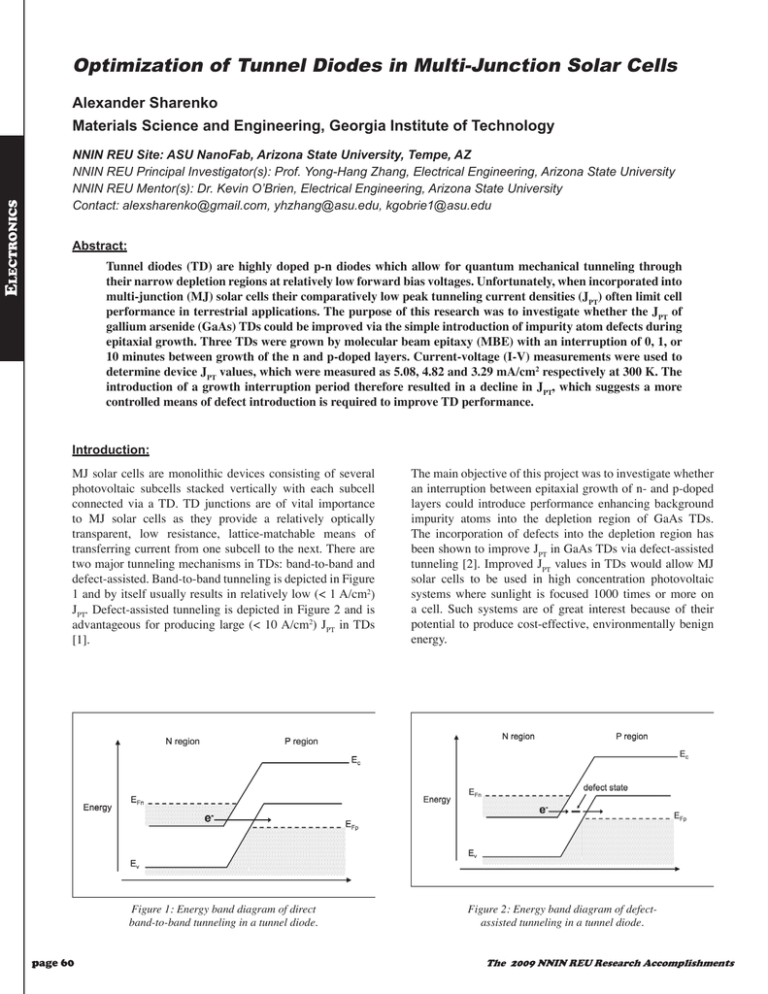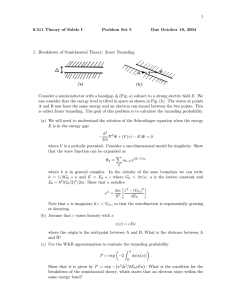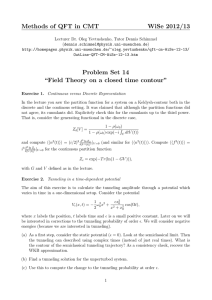Optimization of Tunnel Diodes in Multi-Junction Solar Cells
advertisement

Optimization of Tunnel Diodes in Multi-Junction Solar Cells Electronics Alexander Sharenko Materials Science and Engineering, Georgia Institute of Technology NNIN REU Site: ASU NanoFab, Arizona State University, Tempe, AZ NNIN REU Principal Investigator(s): Prof. Yong-Hang Zhang, Electrical Engineering, Arizona State University NNIN REU Mentor(s): Dr. Kevin O’Brien, Electrical Engineering, Arizona State University Contact: alexsharenko@gmail.com, yhzhang@asu.edu, kgobrie1@asu.edu Abstract: Tunnel diodes (TD) are highly doped p-n diodes which allow for quantum mechanical tunneling through their narrow depletion regions at relatively low forward bias voltages. Unfortunately, when incorporated into multi-junction (MJ) solar cells their comparatively low peak tunneling current densities (JPT) often limit cell performance in terrestrial applications. The purpose of this research was to investigate whether the JPT of gallium arsenide (GaAs) TDs could be improved via the simple introduction of impurity atom defects during epitaxial growth. Three TDs were grown by molecular beam epitaxy (MBE) with an interruption of 0, 1, or 10 minutes between growth of the n and p-doped layers. Current-voltage (I-V) measurements were used to determine device JPT values, which were measured as 5.08, 4.82 and 3.29 mA/cm2 respectively at 300 K. The introduction of a growth interruption period therefore resulted in a decline in JPT, which suggests a more controlled means of defect introduction is required to improve TD performance. Introduction: MJ solar cells are monolithic devices consisting of several photovoltaic subcells stacked vertically with each subcell connected via a TD. TD junctions are of vital importance to MJ solar cells as they provide a relatively optically transparent, low resistance, lattice-matchable means of transferring current from one subcell to the next. There are two major tunneling mechanisms in TDs: band-to-band and defect-assisted. Band-to-band tunneling is depicted in Figure 1 and by itself usually results in relatively low (< 1 A/cm2) JPT. Defect-assisted tunneling is depicted in Figure 2 and is advantageous for producing large (< 10 A/cm2) JPT in TDs [1]. The main objective of this project was to investigate whether an interruption between epitaxial growth of n- and p-doped layers could introduce performance enhancing background impurity atoms into the depletion region of GaAs TDs. The incorporation of defects into the depletion region has been shown to improve JPT in GaAs TDs via defect-assisted tunneling [2]. Improved JPT values in TDs would allow MJ solar cells to be used in high concentration photovoltaic systems where sunlight is focused 1000 times or more on a cell. Such systems are of great interest because of their potential to produce cost-effective, environmentally benign energy. Figure 1: Energy band diagram of direct band-to-band tunneling in a tunnel diode. Figure 2: Energy band diagram of defectassisted tunneling in a tunnel diode. page 60 The 2009 NNIN REU Research Accomplishments Procedure: Results and Discussion: At 300 K, JPT values were measured to be 5.08, 4.82 and 3.29 mA/cm2 for the 0.0, 1.0 and 10 minute growth interruption period samples respectively, as shown in Figure 3. These values are several orders of magnitude below that which is required for use in a high efficiency MJ solar cell under high concentration and indicate that the dominant tunneling mechanism was band-to-band tunneling. A strong linear correlation between the decline in JPT and increasing growth interruption period was observed with a coefficient of determination (R2) value greater than 0.99 as shown in Figure 4. This relative trend held true at all investigated temperatures. A possible explanation for these results is that any impurities introduced into the TDs’ depletion regions had the effect of freezing out free carriers introduced by Si and Be doping, thus widening the depletion region. A wider depletion region would decrease the probability of quantum mechanical tunneling and thus lead to lower JPT. Conclusion: These results suggest the tested TDs predominantly exhibit band-to-band tunneling and that any incorporated impurity atoms only lowered JPT. Also implied is that enabling defect-assisted tunneling in GaAs TDs requires a more controlled, tailored approach than the uninhibited inclusion of background impurity atoms during MBE growth. As future work, the use of transmission electron microscopy to determine the extent of the incorporation of impurity atoms into the TDs’ depletion regions would help confirm that defects played a role in device deterioration. Additionally, experimentally verifying the doping profile of the TD samples would help elucidate the specific mechanism of performance degradation as introduced defects may have led to deviations from the expected doping profile. This is significant because the doping of the device largely determines the band-to-band tunneling probability and therefore lower than expected doping levels could explain the observed decreases in JPT associated with increases in the growth interruption period. The 2009 NNIN REU Research Accomplishments I would like to thank Prof. Yong-Hang Zhang and Dr. Kevin O’Brien for their guidance through this research process. Additionally I would like to thank the National Science Foundation, the National Nanotechnology Infrastructure Network Research Experience for Undergraduates, and the Center for Solid State Electronics Research at Arizona State University for research support and funding. References: [1] K. Jandieri, S. D. Baranovskii, O. Rubel, W. Stolz, F. Gebhard, W. Guter, M. Hermle, and A. W. Bett, "Resonant electron tunneling through defects in GaAs tunnel diodes," Journal of Applied Physics, vol. 104, p. 094506, 2008. [2] K. Jandieri, S. D. Baranovskii, O. Rubel, W. Stolz, F. Gebhard, W. Guter, M. Hermle, and A. W. Bett, "Resonant tunneling as a dominant transport mechanism in n-GaAs/p-GaAs tunnel diodes," Applied Physics Letters, vol. 92, p. 243504, 2008. Figure 3: Tunnel diode I-V measurements at 300 K. Legend denotes time of growth interruption period. Figure 4: Relationship between growth interruption period and JPT at 300 K. page 61 Electronics Three GaAs TD samples were grown using a VG V80H MBE system. N-type doping was achieved with silicon (Si) at a doping concentration of 5 × 1018 cm-3 and p-type doing was achieved with beryllium (Be) at a concentration of 3 × 1019 cm-3. An interruption between the growth of the n and p-doped layers was introduced by closing all the elemental source shutters for 0, 1 or 10 minutes. I-V characterization was then performed on each TD from 80 to 300 K at 20 K intervals using a two wire Lake Shore Cryotonics low temperature probe station. Acknowledgments:






